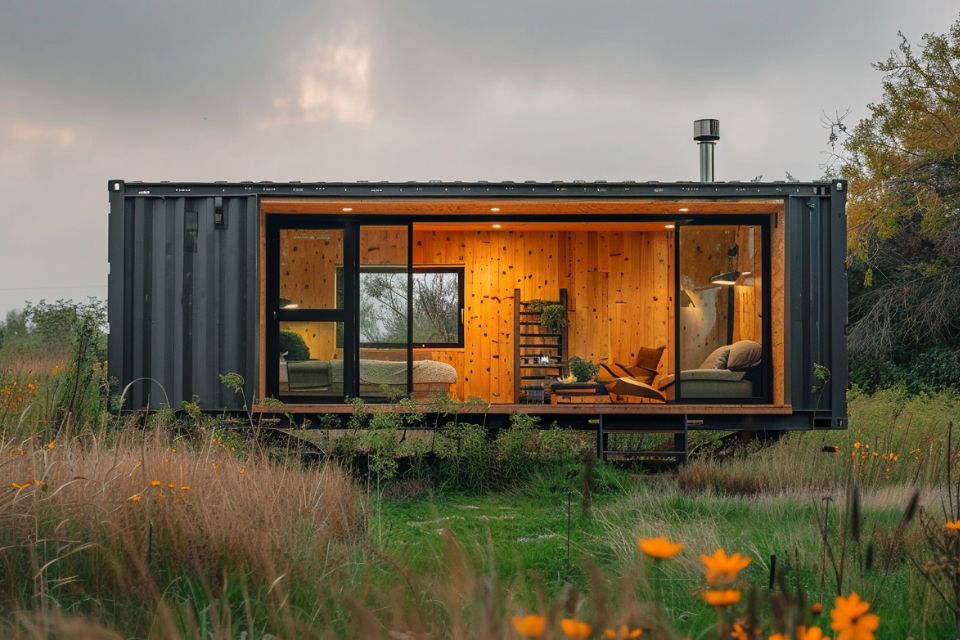Container homes have become increasingly popular due to their affordability, sustainability, and unique design.
Many people consider living in container homes, but safety concerns often arise, especially about fire resistance.
Are these homes really fireproof?
Container homes are not entirely fireproof, but they do have some fire-resistant properties.
While the containers themselves are made of steel, a material that doesn’t easily catch fire, they still need insulation and interior finishes that might be more vulnerable.
Properly selecting fire-resistant materials for these parts and installing smoke detectors and sprinkler systems can significantly enhance the fire safety of container homes.
Things to Note
- Container homes are made of steel, which doesn’t burn easily.
- Interior materials can affect the fire resistance of a container home.
- Using fire-resistant insulation and finishes improves safety.
- Adding smoke detectors and sprinklers boosts fire protection.
- Professional building codes and guidelines should be followed.
Container homes are made of steel, which doesn’t burn easily
Container homes are constructed primarily from steel shipping containers. Steel is known for its durability and resistance to fire. In the event of a fire, steel won’t easily ignite or contribute to the spread of flames.
This makes container homes safer compared to traditional wooden structures in terms of the base structure.
However, it’s important to remember that extreme temperatures can still weaken steel. While the steel frame might not catch fire, it can lose strength when exposed to prolonged high temperatures.
Hence, it’s necessary to take additional precautions to ensure the overall fire safety of the home.
Interior materials can affect the fire resistance of a container home
The interior design choices we make for our container homes play a significant role in overall fire safety.
When building or renovating a container home, the materials we choose for insulation, walls, floors, and ceilings are crucial. Traditional materials like wood and drywall can be more susceptible to fire.
Opting for fire-resistant materials such as gypsum boards, mineral wool insulation, and non-combustible flooring can greatly enhance the home’s fire resistance.
Regularly checking and maintaining these materials ensures they remain effective over time.
Using fire-resistant insulation and finishes improves safety
To further improve the safety of our container homes, we should use fire-resistant insulation and finishes.
These materials are designed to withstand high temperatures and slow the spread of flames. Using spray foam insulation with fire retardant properties is a popular choice.
Similarly, finishes like fire-resistant paint and plaster can add an extra layer of protection.
These efforts not only enhance safety but also provide peace of mind for the occupants. Incorporating these materials during construction or renovation can make a significant difference in the home’s overall fire safety.
Adding smoke detectors and sprinklers boosts fire protection
No matter how many steps we take to use fire-resistant materials, installing smoke detectors and sprinklers is essential for fire safety in any home. Smoke detectors can provide an early warning in case of a fire, allowing us more time to escape safely.
Sprinkler systems are effective in controlling the spread of fire and can significantly reduce damage.
Properly maintaining these systems ensures they function correctly when needed most.
By equipping our homes with these safety devices, we take active steps to protect our families and belongings.
Professional building codes and guidelines should be followed
Building a container home in line with professional building codes and guidelines is essential.
These codes are designed to ensure that homes are safe, durable, and resilient. They include specifications on the materials used, construction methods, and safety features that must be incorporated.
Following these guidelines not only ensures that the container home is safe from fire hazards but can also help in obtaining the necessary permits and certifications.
Consulting with experts and adhering to local building codes during the construction or renovation process is always a wise decision.
FAQs
Can container homes withstand a wildfire?
While container homes have certain fire-resistant properties due to their steel construction, they are not completely fireproof. Proper insulation, fire-resistant materials, and safety systems are crucial to enhancing their resilience in the event of a wildfire.
What materials should I use for insulation in my container home to make it more fire-resistant?
For better fire resistance, consider using materials like mineral wool, gypsum board, or spray foam insulation with fire retardant properties. These materials can withstand high temperatures and slow down the spread of fire.
Is it necessary to install sprinklers in a container home?
Yes, installing sprinklers can significantly increase the safety of a container home. They can help control the spread of fire and minimize damage. Combined with smoke detectors, sprinklers provide a comprehensive fire safety system.
How can I improve the fire resistance of my container home’s interior finishes?
Using fire-resistant paints, plasters, and non-combustible flooring can improve a container home’s fire resistance. These materials are designed to slow down or prevent the spread of fire, thus offering an additional layer of protection.
Are there building codes for container homes regarding fire safety?
Yes, there are building codes and regulations specifically addressing fire safety in container homes. These codes ensure that the construction meets safety standards. Consulting with professionals and adhering to these guidelines is essential for a safe and compliant build.
Conclusion
Building a fire-resistant container home involves more than just relying on the steel structure.
By using fire-resistant insulation and interior materials, adding smoke detectors and sprinklers, and following professional building codes, we can significantly enhance the fire safety of our homes.
Fire safety is an essential aspect of living in a container home, and by taking the right precautions, we can protect ourselves and our loved ones.



